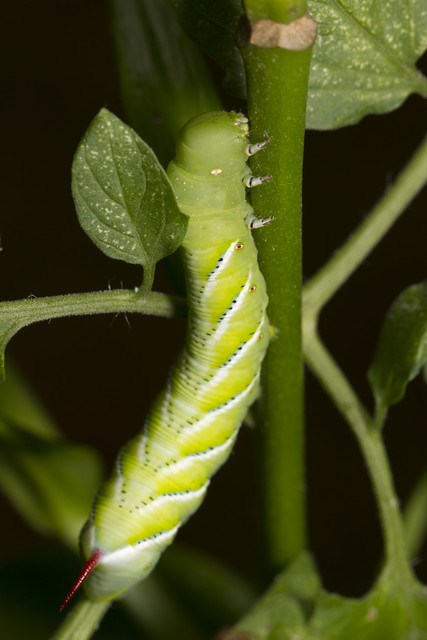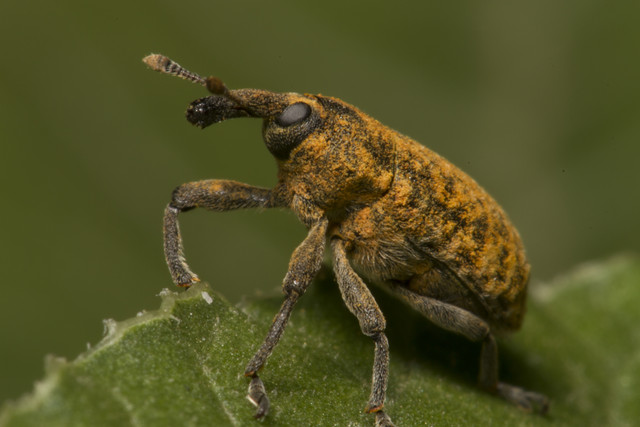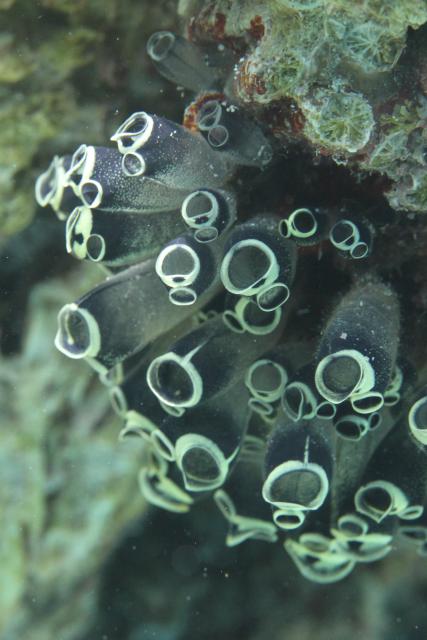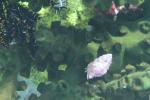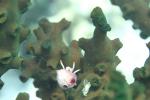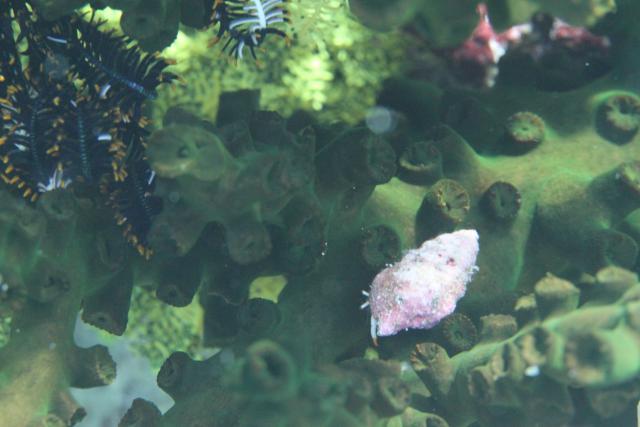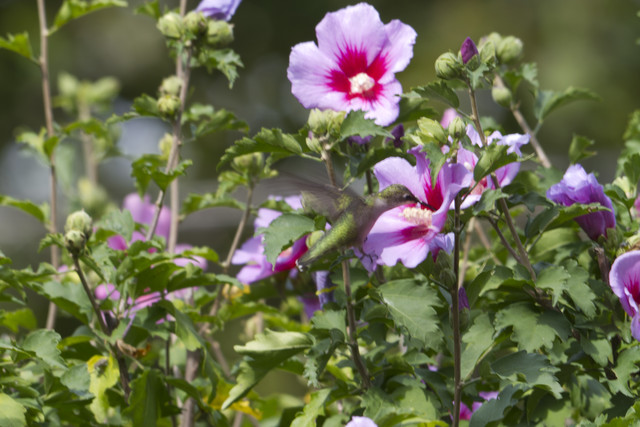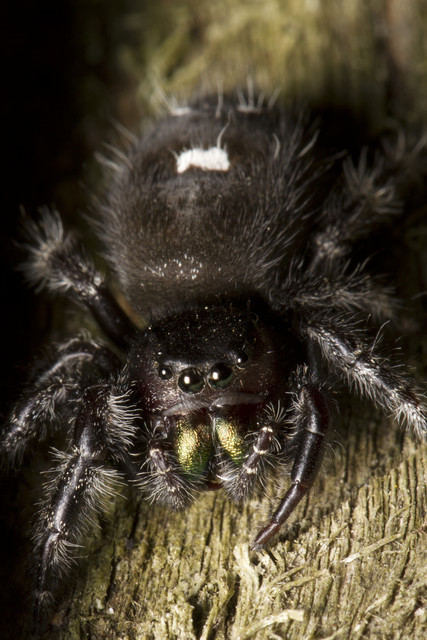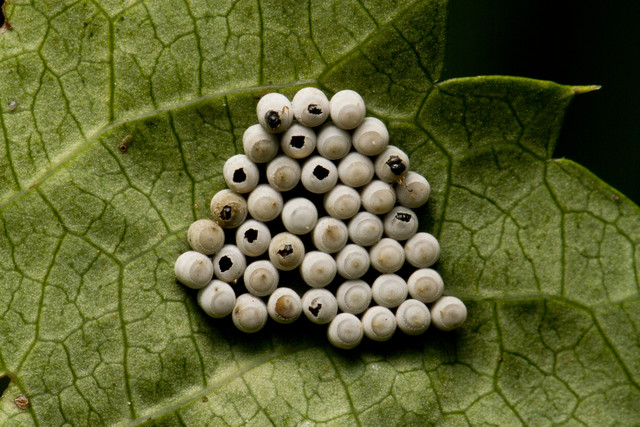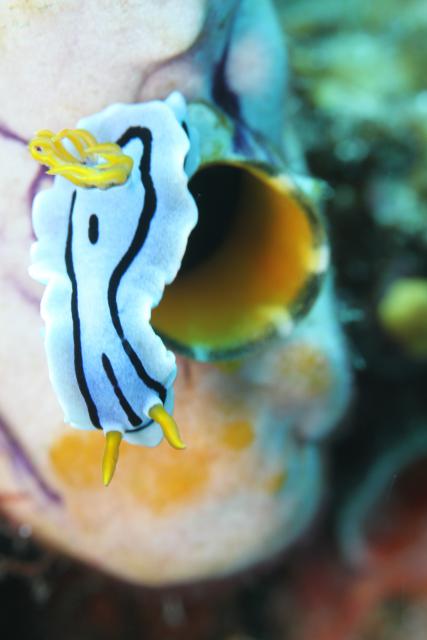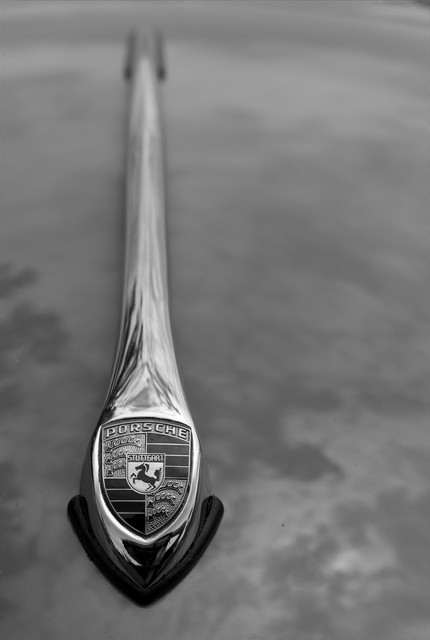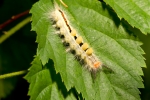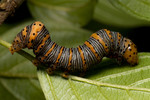Spined Micrathenas
ktuli — Sun, 09/11/2011 - 19:31
These spiders are often found on relatively large webs that they spin across paths through the woods. Interestingly enough, they often build them in a diagonal manner such that you are usually able to duck under them on one side without disturbing the web or the spider - if you see them first of course!
We took a walk through the woods out at Round Hill Park about a thirty-minute drive from our house, and while the day was swelteringly hot, we had no luck finding much of anything else other than these spiders...
But, they're pretty cool spiders once you take a moment to look at them. They look like something you'd expect to see in a tropical jungle, not a deciduous forest here in PA.
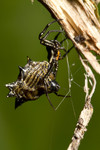 |
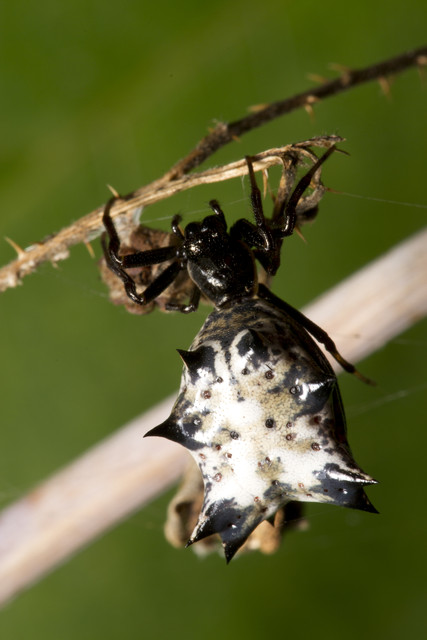 |
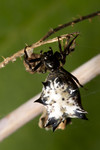 |
|
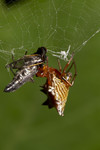 |
Technical Data: Canon EOS 7D, Canon EF 100mm f/2.8L Macro IS USM, 1/200 sec at f/16. Canon Speedlight 580EX II flash in auto mode and wireless control. Image Stabilization on. ISO 100. RAW processing in Adobe Camera Raw. Round Hill Park, Elizabeth, PA.
I am pretty sure that all of these are Spined Micrathenas (Micrathena gracilis). The only one I'm not 100% about is the rusty brown colored one. Most photos I've found of the others are all jet black like the other two.
I really like the detail in the abdomens in these shots - especially in the ones where you are able to see the silk still coming out of the spinerettes. Those concentric rings leading out from the spinerettes really made the abdomens look like they were made of stone - and from what I've read about these spiders, their abdomens with those spines are hard enough that you can actually puncture your flesh if you try to smash the spider by hand.
Pretty cool little spiders.
- Bill
Sphinx Caterpillar
ktuli — Thu, 09/08/2011 - 18:40
I am not 100% certain on the species of this caterpillar, but I am pretty sure it is in the Ceratomia family. This is a group of sphinx hawkmoths.
The species I am leaning towards most with this individual is the Waved Sphinx (Ceratomia undulosa).
This is the moth of Silence of the Lambs fame.
My doubt on the identification comes from the lack of the white stripe on the face of the caterpillar, and the reddish color to the tail spike/horn. But everything else is spot on and I haven't been able to find another species that would fit better.
Technical Data: Canon EOS 7D, Canon EF 100mm f/2.8L Macro IS USM, 1/100 sec at f/8. Canon Speedlight 580EX II flash in auto mode and wireless control. Image Stabilization on. ISO 100. RAW processing in Adobe Camera Raw.
I probably should have went for more depth of field with a smaller aperture, but I was trying to also keep the background from being pitch black (though even that didn't work out so well). As a result, the head of the caterpillar is in clarity while the tail starts to blur out a bit.
I have a couple other angles to share eventually, but while you'd probably expect a caterpillar to be an easy subject to work with, it was actually very difficult to get it to move into good positions, and to stay still once there. As with all caterpillars, they only have six true legs (seen here colored white) and the rest are merely fleshy apendages that have sticky pads on the end of them - making them very difficult to detach unless they want to.
A challenging, yet very cool subject.
- Bill
Boll Weevil
ktuli — Wed, 09/07/2011 - 17:59
Been having a hard time coming up with things to write about, so just going to share another photo today. Our subject for this one is a boll weevil of some sort.
Technical Data: Canon EOS 7D, Canon EF 100mm f/2.8L Macro IS USM with Kenko Teleplus PRO 300 "DG" AF 2x Teleconverter, 1/250 sec at f/16. Canon Speedlight 580EX II flash in auto mode and wireless control. Image Stabilization on. ISO 100. RAW processing in Adobe Camera Raw.
- Bill
Wakatobi: Tunicates
ktuli — Tue, 09/06/2011 - 19:44
Just stopping by to share another shot of some more tunicates.
Technical Data: Canon EOS 7D, Canon EF 100mm f/2.8L Macro IS USM, 1/170th sec at f/11.3. Image Stabilization on. ISO 2000 (Auto). Ikelite Housing and Port with Ikelite DS161 Strobe in TTL Mode. No post production.
- Bill
Wakatobi: Hermit Crabs in Pink Shells
ktuli — Mon, 09/05/2011 - 13:31
I really can't wait till my upcoming dive trip, so I've been going back through some of my old shots trying to figure out what I could have done better. In particular, the one major problem with both of these images is the perspective. The top down view is not simply not very appealing. In this case, it was necessitated by the subjects' positions within the coral.
Oddly enough, these shots were taken on different dives, but they appear to be on the same species of coral. Further, the hermit crabs may even be the same species (notice the white legs with orange tips). However, the top down view makes identification almost impossible.
Technical Data: Canon EOS 7D, Canon EF 100mm f/2.8L Macro IS USM, 1/60th & 1/25th sec respectively at f/11.3. Image Stabilization on. ISO 3200 & 400 (Auto). Ikelite Housing and Port with Ikelite DS161 Strobe in TTL Mode. No post production.
I'm sure I'll still use this technique when absolutely necessary, but will also try to make sure I get different angles of subjects when possible.
- Bill
First Hummingbird Shot
ktuli — Sat, 09/03/2011 - 19:21
So we've managed to get a hummingbird to be a regular visitor to our yard this summer. So one Sunday morning after I got home from playing hockey, I noticed her stopping by the feeder and rose of sharon bushes. So I quickly went and got my camera with the Sigma 150-500 and my new tripod (have I mentioned that yet? I don't think I have! I guess I should get around to talking about that at some point, but not right now).
Anyway, I setup and managed to get just a few shots before she wandered off again and I had to go work on some bathroom tile repair work. Unfortunately, I totally did not think things through, and I used a rather slow shutterspeed of 1/30th of a second. Far too slow to keep such a fast moving subject from blurring.
But considering they were my first ever hummingbird shots, I kept a couple just the same...
Technical Data:Canon EOS 7D, Sigma 150-500mm f/5-6.3 APO DG OS HSM at 500mm, 1/30 sec at f/11. OS mode off. ISO 100. Raw processing in Photoshop CS5.
Sorry - no mouseovers for a cropped view on this one... it would just show you just how bad the blur is. At least at the smaller version, it makes it a little tougher to see the blur.
Hopefully I'll get another chance at this before the end of summer and she leaves for warmer climates... next time I'll know to use a faster shutterspeed!
- Bill
Another Jumping Spider
ktuli — Thu, 09/01/2011 - 20:19
Jumping spiders are quickly becoming my favorite subjects... and this one was probably the largest jumping spider I've ever seen. If my calculations are correct, he was about 15mm long, and for jumping spiders, that's pretty hefty. But here he is in much larger detail.
Technical Data: Canon EOS 7D, Canon EF 100mm f/2.8L Macro IS USM, 1/250 sec at f/16. Canon Speedlight 580EX II flash in auto mode and wireless control. Image Stabilization on. ISO 100. RAW processing and cropped in Adobe Camera Raw. Powdermill Nature Reserve.
- Bill
Hatching Wasp Eggs
ktuli — Wed, 08/31/2011 - 20:44
I have to admit something about this photo - when I took it, I didn't even notice the fact that these eggs were hatching. In all fairness, they are only about 1mm in size, so they were pretty tiny.
Anyway, I happened to catch a glimpse of these white eggs attached to the underside of a leaf, so while I held the lead over with one hand, I had to steady the camera and shoot with the other. Not necessarily the easiest thing to do. Add in that the bright sun was wreaking havoc with my wireless flash capabilities (I need to remember to keep my sync cord with me for cases like that).
However, once I got home and looked at these on the computer, I realized that the wasps were actually in the process of hatching right then! Had I realized that at the time, I most certainly would have taken much more time with this subject and used the 2x teleconverter to get some even closer detail. As it is, you'll have to settle for a crop (mouseover the image for the cropped view).
Technical Data: Canon EOS 7D, Canon EF 100mm f/2.8L Macro IS USM, 1/250 sec at f/16. Canon Speedlight 580EX II flash in auto mode and wireless control. Image Stabilization on. ISO 160. RAW processing and cropped in Adobe Camera Raw.
Due to the bright sunlight, I don't think the flash actually fired, so I had to do some significant brightening of this in post production, and because of my less than recommended one-handed camera stabilizing techniques, there is a bit of camera shake blur that the IS wasn't able to fix (normally 1/250th a second wouldn't be a problem to hand hold, but with the flash bracket and one-handed operation, apparently that isn't the case).
Regardless, I thought the original image was interesting because of the beautiful pattern the eggs create, but finding the bonus of the wasps actually hatching is really really cool if you ask me.
- Bill
Wakatobi: Elisabeth's Chromodoris
ktuli — Mon, 08/29/2011 - 20:29
Well, it is official! I have my next dive trip scheduled! This time around, we'll be trying out some live-aboard diving with Caribbean Explorer going to Saba, St Kitts, and St Maarten.
To celebrate, here's a quick shot of another nudibranch from Wakatobi in Indonesia.
Technical Data: Canon EOS 7D, Canon EF 100mm f/2.8L Macro IS USM, 1/25th sec at f/8. Image Stabilization on. ISO 400 (Auto). Ikelite Housing and Port with Ikelite DS161 Strobe in TTL Mode. No post production.
The nudibranch is an Elisabeth's Chromodoris (Chromdoris elisabethina) and it is crawling on a tunicate.
I can't wait to go diving again!
- Bill
PVGP 2011 (part 7)
ktuli — Wed, 08/24/2011 - 19:04
Ok - sorry for the lack of posts recently. I've been alternatively too busy or too tired or just a bit unmotivated, but I am forcing myself to try and get back to more regular posts.
This year's marque was Porsche, so there were plenty to shoot. I liked this hood ornament and thought the shallow depth of field would be nice as the ornament swept back along the hood of the car.
I took a couple shots of this hood, and eventually liked this offset version the best - I tried a perfectly centered version, and it just didn't work for me.
If you mouse over the shot, you will get to see the original, and you can get a feel for the post production edits that I did to make this shot a bit nicer. First, I rotated slightly clockwise to get the hood ornament perfectly vertical - it had a very subtle tilt before, but it was enough that I could see it. Next, I used some content aware fills to fill in any gaps left by the rotation (I could have also cropped to take care of them) and to remove the bright reflection from the hood as it was very distracting.
Finally (and obviously), I converted to black and white. For the most part, this is another shot (like the MG Wheel) that really doesn't change that drastically going to black and white, but the effect really helps to clean things up and make the shot really stand out nicely. In particular, the black and white treatment helped to make the Porsche emblem much more readable than it was in the color version. By removing the color and highlighting the contrast, it made that feature much more prominent in the frame.
Technical Data: Canon EOS 7D, Canon EF 50mm f/1.8 II, 1/1000 at f/5. ISO 100. 2011 Pittsburgh Vintage Grand Prix, Pittsburgh, PA. Raw conversion, modifications, and B&W conversion in Photoshop CS5 (mouseover for original).
Thanks for stopping by.
- Bill

